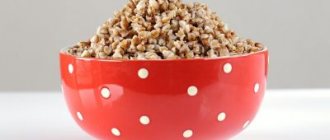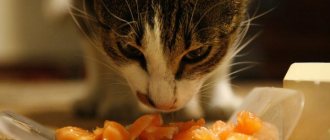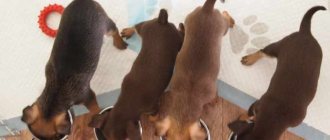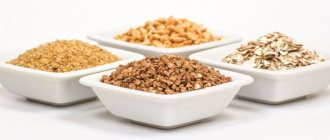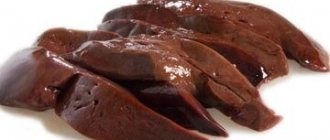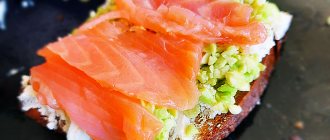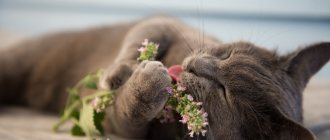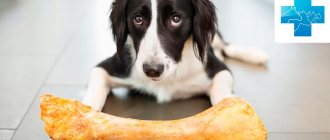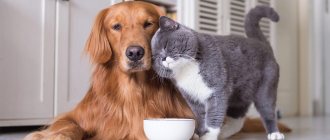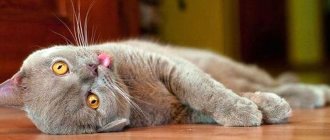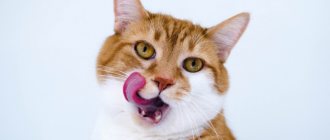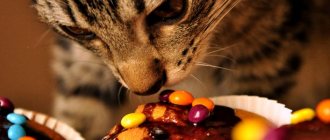Once upon a time, a man tamed a cat so that it would protect barns from rodents, because it eats mice and rats, but does not eat grain. But millennia passed and feeding cats porridge suddenly became a tradition. However, before you pour cereal into water to make porridge for your pet, read this article. It turns out that not everything is so simple.
The article is part of the Natural Cat Nutrition section. The article continues after the advertisement.
Feeding cats porridge: three opinions
On the question of what kind of porridge to cook for cats, kittens and cats, and whether this can be done at all, there are three different points of view.
Opinion No. 1. The first point of view about whether cats and kittens can eat porridge says that it is not only possible, but also necessary. This opinion, by the way, is shared by many veterinarians. They explain their point of view by the fact that the stomachs of the victims of cats - mice and birds - contain cereals. Therefore, porridge is a must in the diet as a source of fiber, vitamins and microelements. Adherents of this point of view clarify which porridge is best to feed a cat, kittens and cats, and which one is not worth it. But there is no common opinion on this matter between supporters of the theory. Some people allow buckwheat, rice and oatmeal. Someone says that rice is strictly forbidden, but buckwheat, oatmeal and barley are ok. And so on. You can hear many different opinions about this or that type of cereal.
Opinion No. 2. The second point of view says that cereals for cats are more likely to cause harm than benefit, but they are still acceptable if the animal does not have obvious negative reactions to such food. There are also quite a lot of veterinarians among adherents of this point of view. At the same time, they stipulate that cats cannot have porridge every day and its share should be up to 25% of the diet, but better - 5-10%.
Opinion No. 3. The third point of view on whether it is possible to feed a cat, cat or kitten with porridge, the answer is a categorical “no”. In nature, cats do not eat porridge, and the grains that fall into the cat along with the victim’s stomach make up a microscopic amount, moreover, they are already fermented by the rodent’s body. And many cats avoid eating the stomach and intestines, because... These parts are the most tasteless. Therefore, cereals that are healthy for kittens simply do not exist. A cat can get fiber not from grains, but from vegetables. It is needed in an amount of no more than 5-10% of the diet. And in any case, the cat will not even absorb vitamins and microelements from cereals, because... Her body can obtain everything it needs only from products of animal origin, because... The cat is an obligate (“obligatory”) predator.
Why is there three points of view on the simple question of what kind of porridge can be cooked for a cat, cats and kittens? Was it really impossible to come to a common opinion? The reason for this range of opinions lies in several reasons.
Firstly, cats have a pancreatic enzyme called amylase, which can break down grains. Nature gave it to the cat just in case, because, indeed, in addition to the prey, a predator can also get some amount of carbohydrates into the stomach. But the problem is this: just because a cat CAN process microscopic amounts of grains that accidentally enter its stomach does not mean that they are USEFUL. Supporters of the first two points of view forget about this.
Secondly, there is a tradition that comes from the USSR, when, in conditions of shortages and saving money, people fed cats and dogs with porridge. This tradition has been preserved in many families to this day, and many veterinarians simply accommodate people who want to save money. This is usually done by supporters of the second point of view, who understand that porridge is not a very suitable food for cats.
Article continues after advertisement
Thirdly, feed manufacturers played a major role in shaping opinions regarding the benefits of cereals, adding cereals to feed in order to save money. Under this, they brought a whole theoretical basis about the contents of the stomach of a mouse, which is now cited by many veterinarians - supporters of factory nutrition. At every seminar and conference for veterinarians and felinologists, company representatives tell this theory. In addition, as you know, feed manufacturers have contracts with each clinic regarding a percentage of feed sales. Please note that almost all clinics have signs of some kind of food or stands with these products inside.
The author of the article you are reading initially fed the cats cereal on the advice of a veterinarian. However, then, having studied all three points of view, I came to the conclusion that the third opinion on the ban on grains is the most correct. What made me think about this was immersing myself in the intricacies of feline physiology and studying the opinions not of ordinary veterinarians, whose level of knowledge varies, but of the best veterinarians in the world. Agree, there are many specialists, but you need to listen only to the best.
Further in the article we will consistently prove the correctness of the third point of view, and will also tell you which cereals are the most harmful and how you can replace cereals in your diet.
Suitable Ingredients
The question of what kind of porridge to cook for a cat is usually decided by the assortment of the pantry (refrigerator). An unpretentious pet will eat any cereal cooked in meat or fish broth. But it is better to choose the right product. A cat, indoor or outdoor, deserves healthy food. Many suitable and harmful cereals cost about the same.
Cereals
Affordable, useful solution. The answer to the question whether cats can have oatmeal is positive for all mousecatchers. Breed or age affect the amount of grain in the diet. An illness that impairs digestion, impedes the ability to chew, or weakens appetite may require you to give it up. But, in general, oatmeal is good for cats and is a source of:
- fiber;
antioxidants;
vitamins (B, E);
amino acids;
microelements (zinc, selenium, iron).
The cereal does not contain gluten - another factor in favor of the statement whether cats can have oatmeal porridge. Proteins in this group (specifically, gliadin) can cause allergies in cats, manifested by diarrhea and skin problems. Oats are a crop that is rarely subject to genetic modification. Boiled flakes acquire a soft, easy-to-eat texture. Broth-based porridge with meat (at least 50% of the serving) will replace store-bought wet food.
Rice
Another answer to what kind of porridge can you feed cats. Rice is easily digestible, has a neutral taste, and contains a large amount of nutrients. Cereal helps normalize stomach function. The kitten can become accustomed to solid food, starting with rice boiled in milk or broth.
It is important to give your animal only cooked grains. Raw rice is dangerous
It is harder to digest and may contain pesticides that can cause vomiting or stomach upset. The share of cereal in a serving should not exceed 25-30%. Some consider rice to be a useless filler. But it helps the functioning of the gastrointestinal tract, and animals like it because of its neutral taste.
Legumes
Limited quantities allowed. When figuring out what kind of cereal cats like, peas are often the answer. Many animals love this Olivier ingredient, drinking the brine and begging for the fruit. Pea porridge added to meat will evoke similar sympathy. Small amounts of legumes, including lentils, are safe for cats. With them the pet receives:
- vegetable protein;
fiber;
vitamins (B, C, K);
minerals (iron, manganese, potassium, copper).
Young peas can be given raw as a treat. Be sure to cook the beans completely. The half-raw product contains toxic substances. Cats like the soft texture and specific taste of ready-made legumes. They are easy to grind, discreetly introducing them into the diet.
The main thing is not to overdo it. An abundance of beans will cause indigestion and increased gas formation. It is worth limiting their share to 15-20%.
Corn
"Queen of the Fields" received mixed reviews. Western sources classify polenta as an acceptable solution to the question of what kind of porridge to cook for a cat. Russian-language sources call corn an unsuitable food that causes constipation and gas. Culture should be considered a compromise. Many cats love boiled (canned) corn and porridge made from it. The product should be given as a treat.
Pumpkin
A healthy vegetable for people and cats. A low-calorie, fiber-rich product helps cope with indigestion and has a positive effect on the functioning of other internal organs. Boiled pumpkin has a relatively neutral taste.
Buckwheat
A cereal rich in nutrients. Includes vitamins B, PP and E, an abundance of microelements:
- iodine;
potassium;
selenium;
calcium;
iron.
The main problem is the specific taste and smell. The pet refuses food even with a small amount of buckwheat.
Unwanted cereals
The category includes all wheat derivatives. No - the answer to the question, can cats have semolina porridge? The reason is the abundance of gluten, which can cause allergies and digestive problems. Wheat is rich in carbohydrates, which promote fat storage.
It is not advisable to feed cats millet. It causes constipation and worsens the condition of patients with diseases of the large intestine. Mixtures of cereals should be avoided. While useful individually, together they can create an indigestible cocktail.
No - the words of a veterinarian to a client wondering if a cat can have semolina porridge. Wheat is difficult for the animal to digest. But you can’t completely exclude grains and other crops from your diet.
When asked if cats can have oatmeal, the answer is yes. Rice and buckwheat (up to 30-50%) are suitable for pets. Corn and legumes are acceptable in small quantities (up to 20%).
What cereals can be cooked for cats, kittens and cats?
Beginning cat breeders are wondering what cereals can be given to kittens and adult cats and how to teach a cat or kitten to eat porridge? We are all accustomed to the fact that porridge is good for people, because... it gives a lot of energy. As a child, our mother and grandmother told us: we need to eat porridge in order to grow up strong and healthy. We remembered this and now we are trying to use it on cats, because we want only the best for them...
But the cat’s body works differently: cats are predators that can process a certain amount of grains, but such a product is not only not necessary for them, but can also cause harm. Open any textbook on cat physiology: cats only need proteins and fats of animal origin to live - they get all the useful vitamins and minerals from meat and bones. At the same time, their body is adapted to process small amounts of carbohydrates that make up cereals, thanks to the pancreatic enzyme amylase. It is this enzyme that cats owe to the fact that their owners now stuff them with porridge, sometimes even without meat. And it is precisely the fact that cats have amylase that digests cereals that is cited as an argument by veterinarians who are supporters of feeding cats porridge.
But let's figure out why the world's leading veterinarians - specialists in feeding cats - are against this. In particular, we are talking about Doctor of Veterinary Medicine Karen Baker, veterinary nutritionist Lisa Pearson, nutritionist Kimity Schultz and many others. The fact is that quite a lot of research has been conducted showing that grains (cereals) are harmful food for cats. In nature, predators do not eat this, so we will not think about how to force a cat or kitten to eat porridge or how to trick a cat into feeding it porridge, for example, by boiling it in broth. Why, even if a kitten or cat loves and eats porridge, is it better not to offer such food?
It turns out that during the normal physiological process, the enzyme amylase for digesting cereals in cats is just enough to process several grains that got inside along with the stomach of the victim - rodents and birds. But this measure is forced, cats have amylase so that, having consumed the mouse along with the stomach, the cat does not diarrhea and waste the precious meat, caught with such difficulty.
In addition, as we have already said, the cereals in the mouse’s stomach have already begun to undergo fermentation. This is not at all the same porridge that people offer their pets. This is called chyme. In addition, cats often do not want to eat the stomach and intestines of the victim. Thus, a pancreatic cat needs to secrete very little amylase in order to process those single grains that sometimes fall along with the carcass. This is how it works in nature.
But a person feeds a cat grains differently. Firstly, they are not fermented by a rodent's stomach. Secondly, owners offer their pets porridge regularly and obviously not just a few grains at a time. Thirdly, porridge is often also cooked in meat broth, which causes additional damage to the digestive system. That is, conditions are artificially created under which the cat regularly consumes a significant amount of grains. This raises a number of serious problems.
Do felines naturally eat any grains?
In the wild, cats do not eat grains, but they do feed on small animals and birds, which they ingest along with feathers and stomach and intestinal contents. The gastrointestinal tract of all representatives of the cat family is adapted to digest animal food, so pets should be offered chicken, lamb, beef, rabbit, and offal.
If we consider the chemical composition of cereals, then, of course, each cereal is rich in certain vitamins, minerals, and fiber, which are very useful and necessary in the animal’s diet. For the owners, the indisputable advantage is the low cost and ease of preparation of such dishes.
However, do not forget that cereals are a source of complex carbohydrates. And since cats by their nature are not very active (they spend about 80% of their time sleeping), frequent consumption of porridge can lead to obesity and other associated pathologies.
But you also can’t do without porridges, because they stimulate intestinal motility and help cleanse the body. The optimal proportion of grains in the general diet is 20% (2-3 meals per week). A larger amount of product is no longer desirable for a furry pet.
Why can't cats have porridge?
As you already understand, the answer to the question of what cereals cats, cats and kittens can eat is “none.” In any case, we propose this point of view as the main one. In nature, a cat does not eat porridge. You can force it to do this by mixing cereals with meat - the main product in the predator’s diet. But this can cause harm. Let's list specific reasons why your cat should not be offered porridge.
Article continues after advertisement
Why are grains dangerous for cats?
- Grains are not a natural food for cats. During the time that the cat began to live with humans, it did not have time to evolutionarily change the type of digestion. Cats, like true predators, have a very short intestine, and carbohydrates are digested there. Herbivores have very long intestines for these purposes. The cat's short intestine does not have time to cope with grains. Therefore, at best, they pass through the gastrointestinal tract in transit without being absorbed. At worst, they cause harm.
- Phytic acid, contained in all cereals, leaches existing mineral reserves from the body, which is dangerous to health.
- Gluten, contained in some cereals, is a dangerous substance that leads to allergic reactions, inflammation, decreased immunity and other negative consequences, including mental disorders. You can read more about gluten in grains and their effect on dogs and cats in an English-language article by veterinarian Karen Baker.
- All grains are potent allergens for cats.
- Grains can in some cases damage the mucous membranes of the gastrointestinal tract of cats.
- Cereals are often contaminated with mycotoxins and other poisons. Eating contaminated grains sometimes causes serious consequences, including the death of the animal.
- The consumption of cereals contributes to the disruption of the barrier functions of the mucous membrane of the cat's bladder, as a result of which an ascending infectious process can begin and struvite stones appear.
Now let’s take a closer look at some of the nuances that are worth focusing on.
Digestive disorder
The most harmless thing that can happen is that the porridge will give your cat diarrhea. This occurs when the pancreas secretes very little amylase - as a result, consuming grains that cannot be digested in any way causes indigestion. This may also cause blood in the stool and gas.
However, many cats do not have diarrhea from grains, but only become profuse in their stool, in which, if desired, you can sometimes even see undigested grains. Most owners do not pay attention to this, and therefore continue to feed their pets with cereal. As a result, much more serious consequences may develop. It would be better if there was diarrhea, which would force the owner to completely stop feeding grains.
Rarely does porridge cause constipation. In this case, the cereal masses stand like a stake in the intestines, peristalsis slows down. This whole mass begins to rot, causing illness. But the cat’s owner, of course, would not think that porridge could cause constipation, because for people it’s the other way around: cereals relieve constipation.
EXPERT COMMENT
